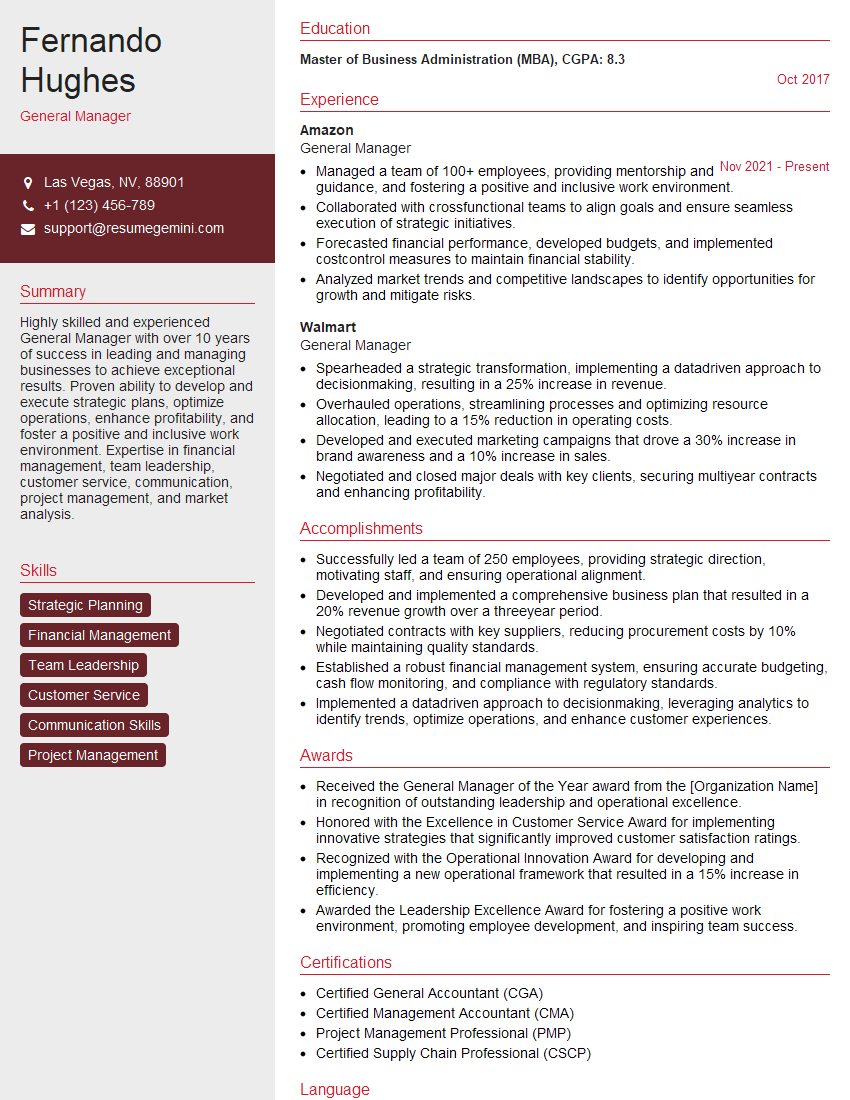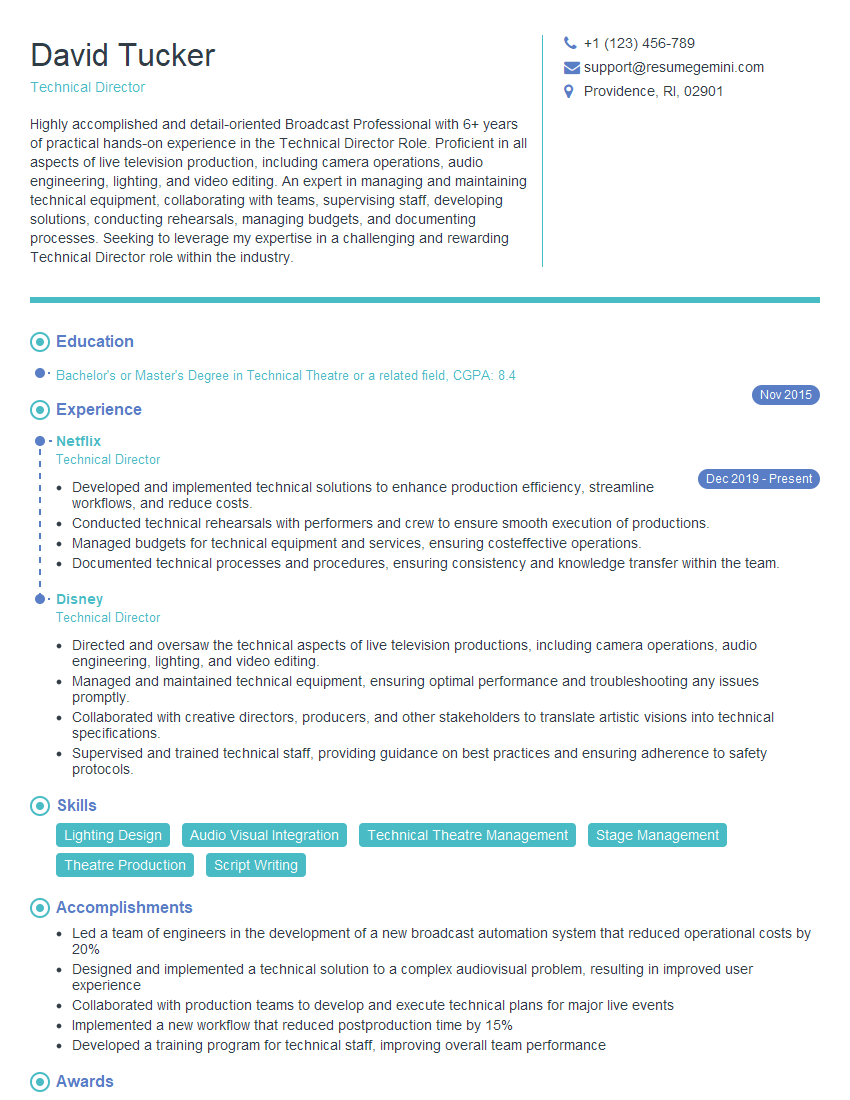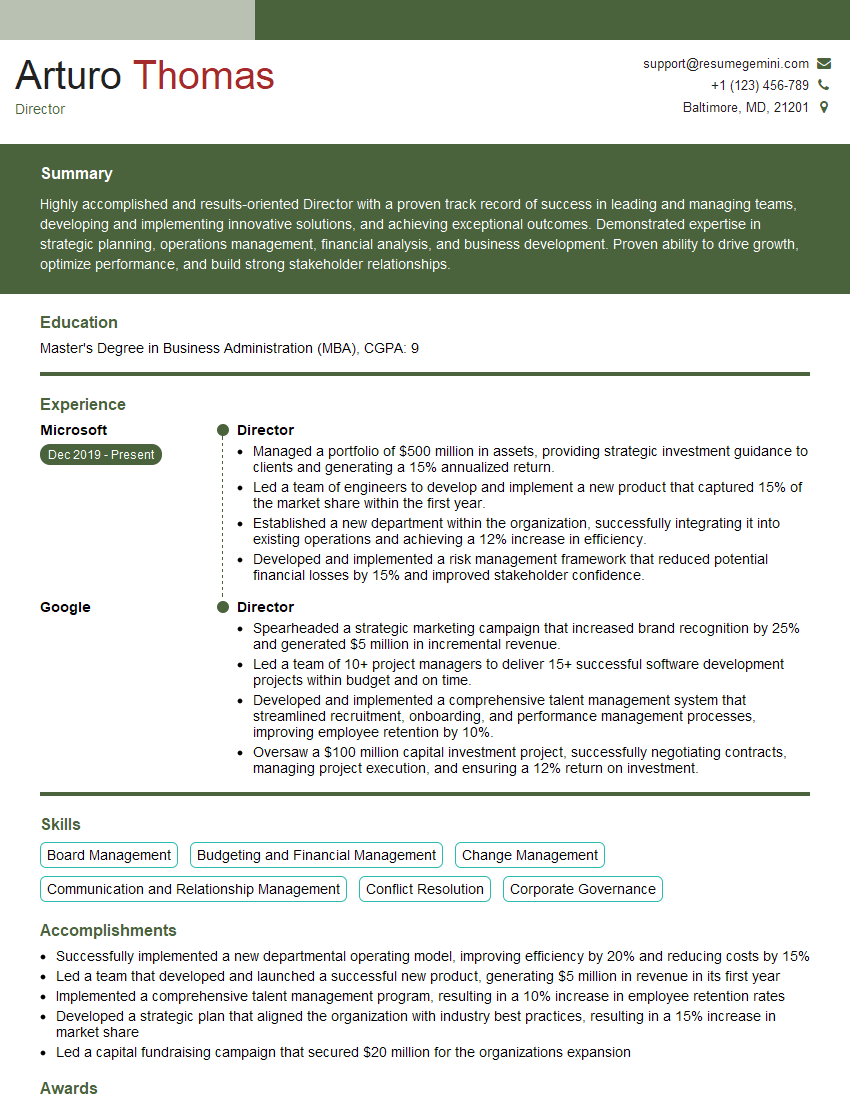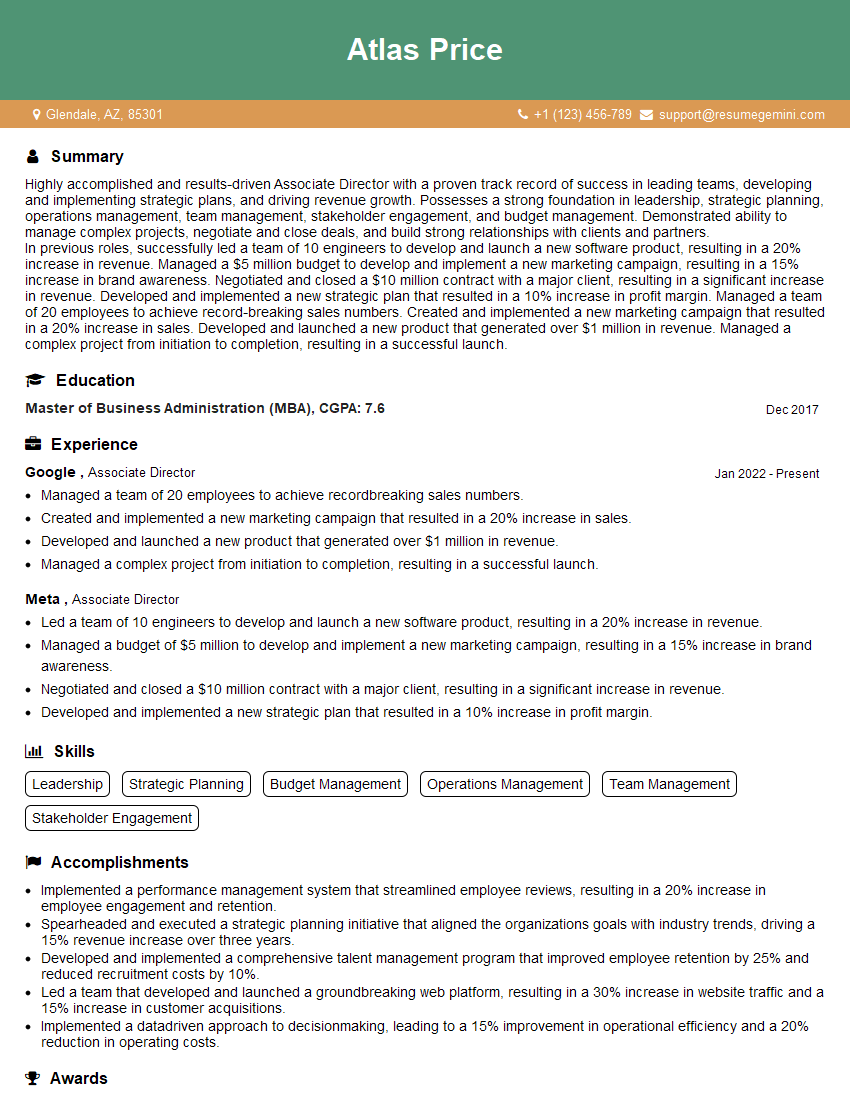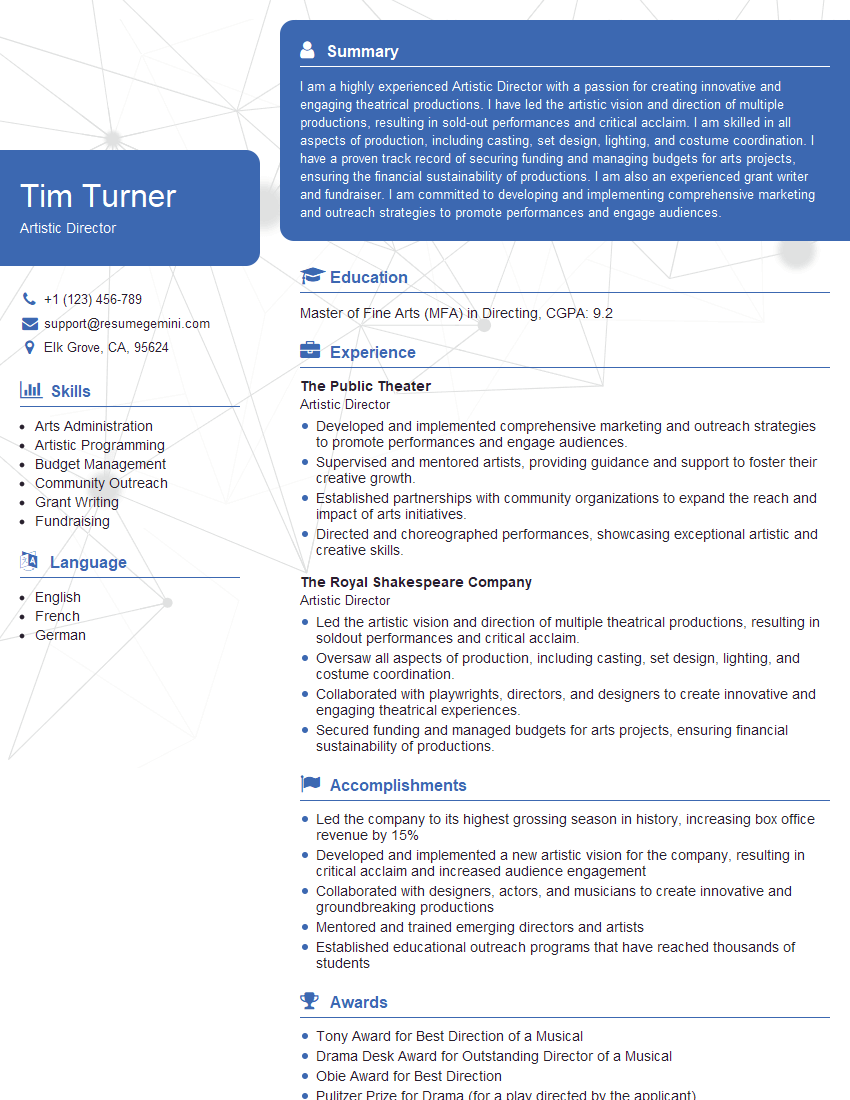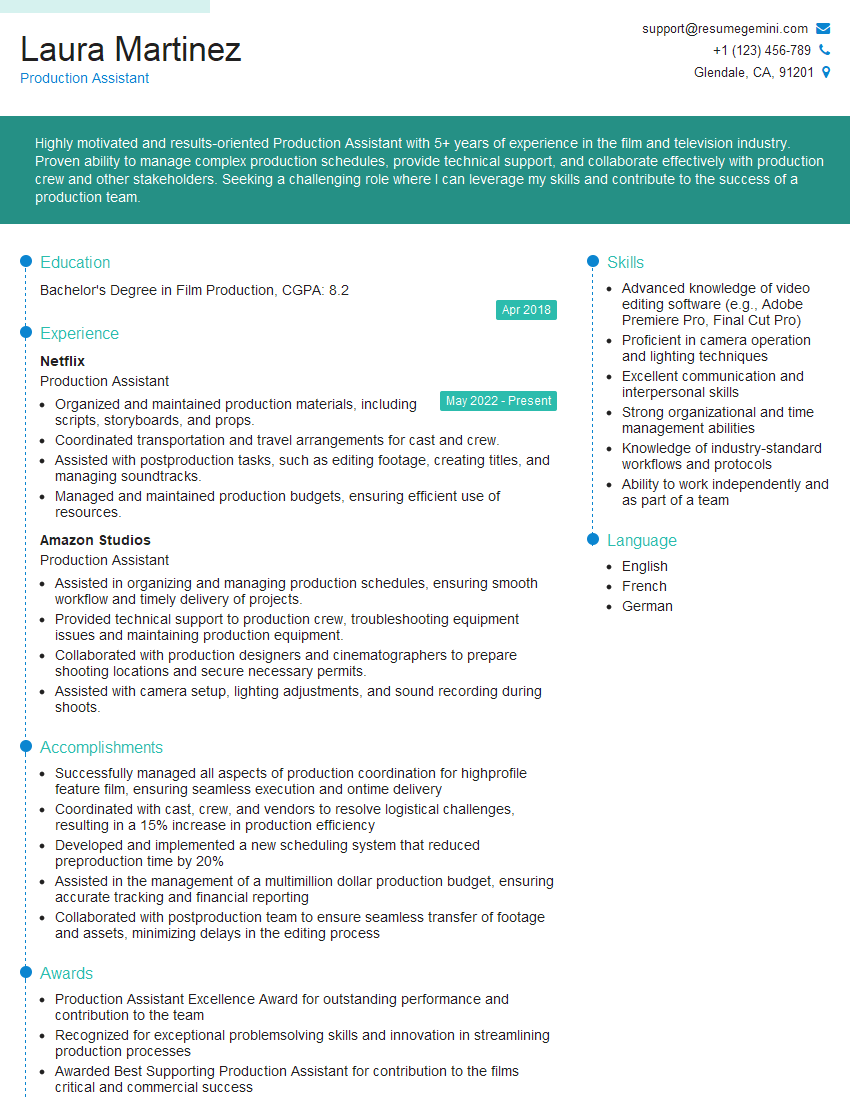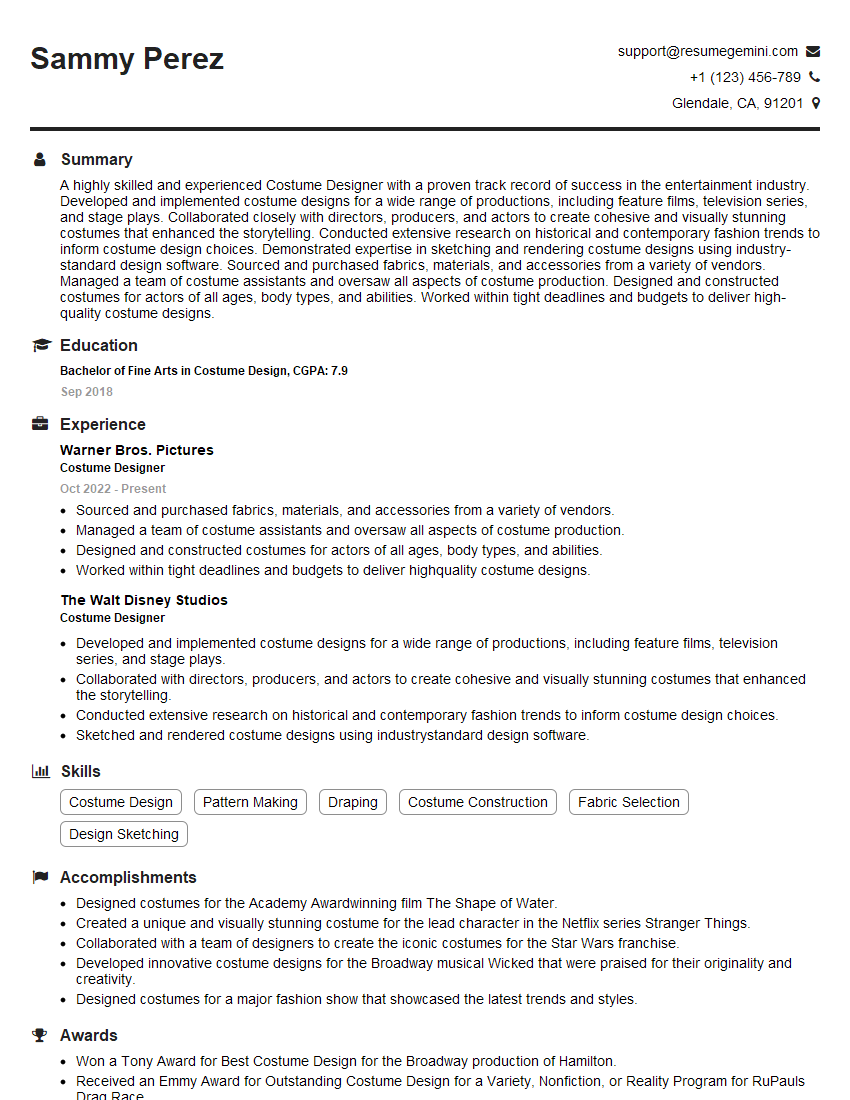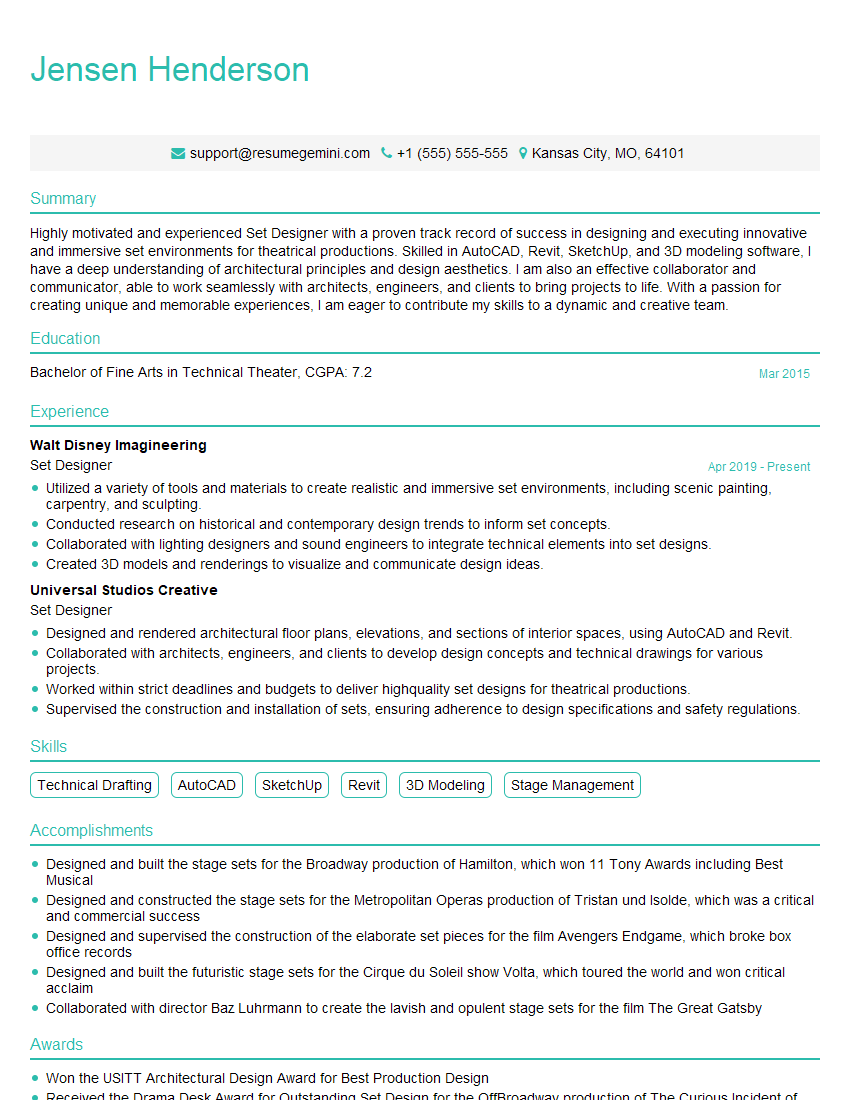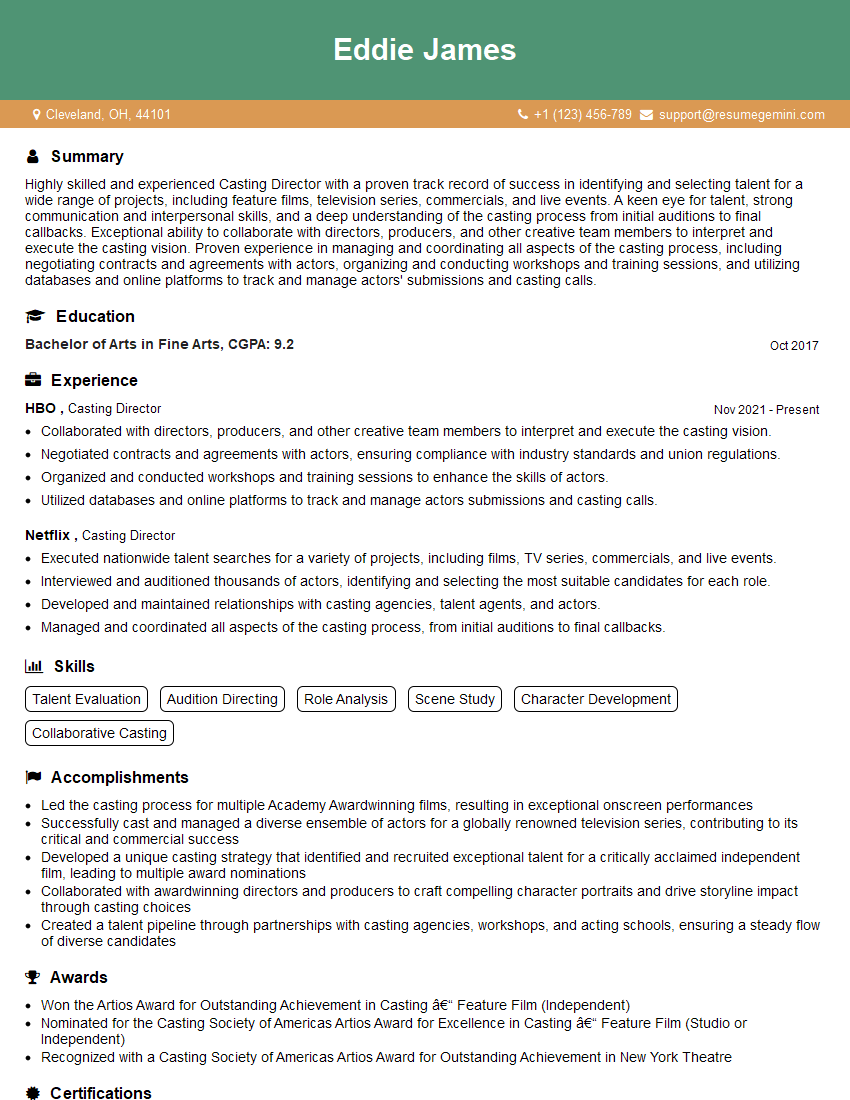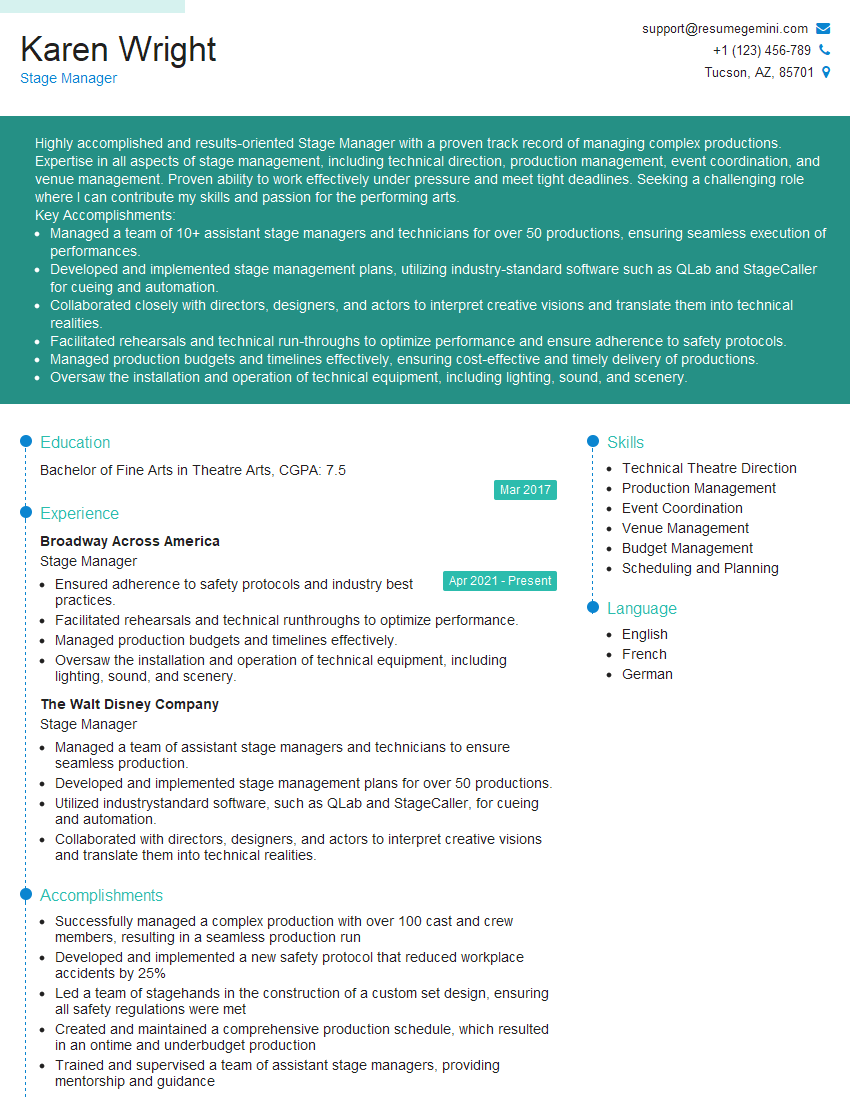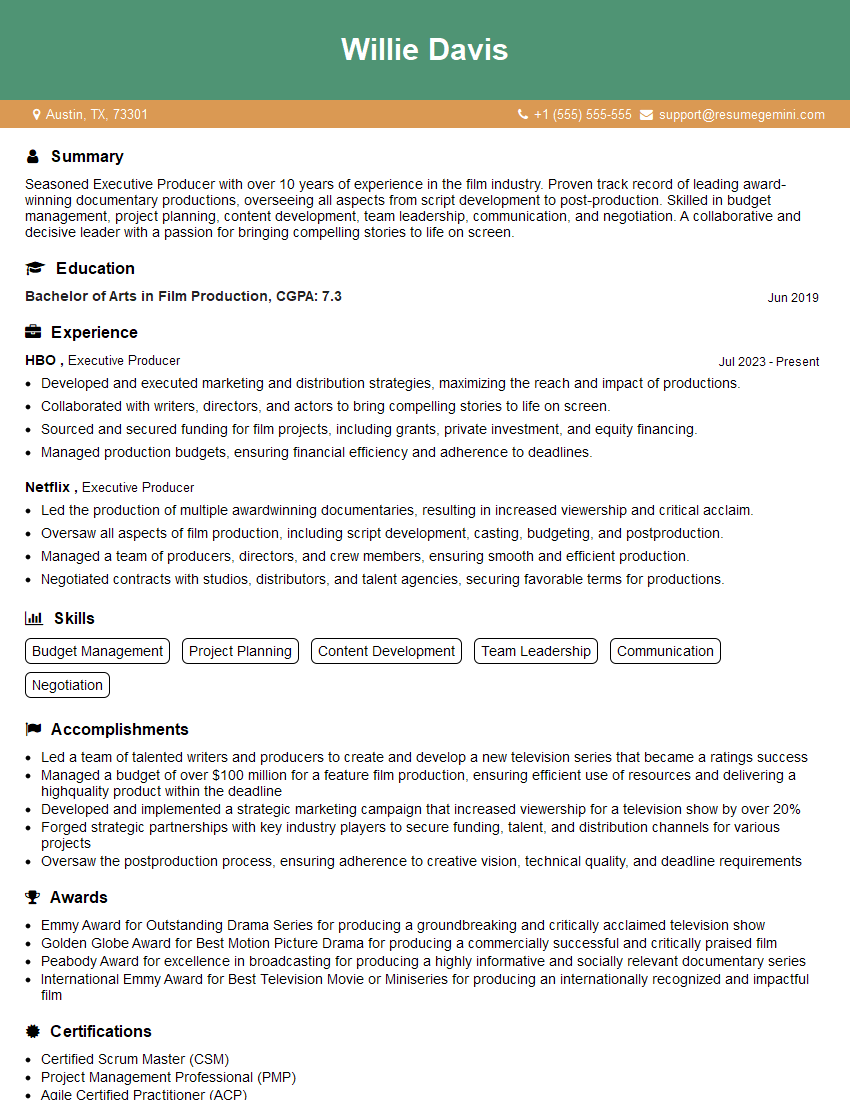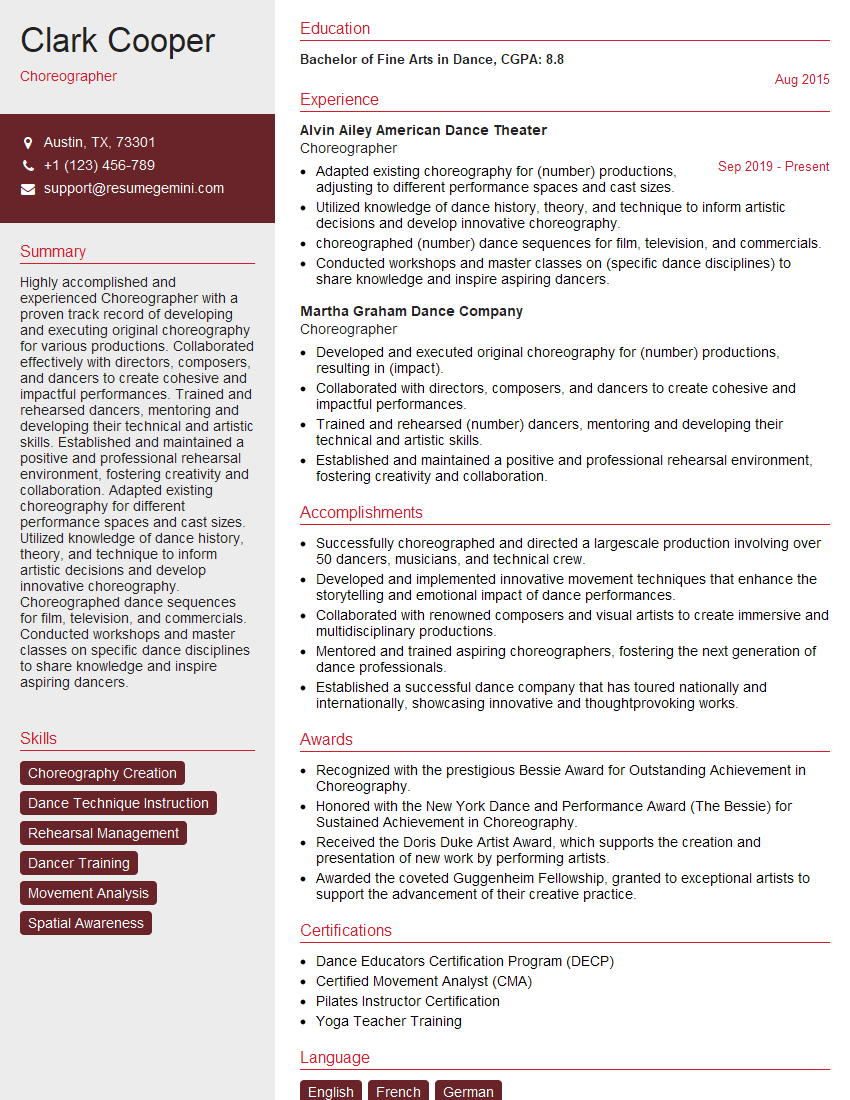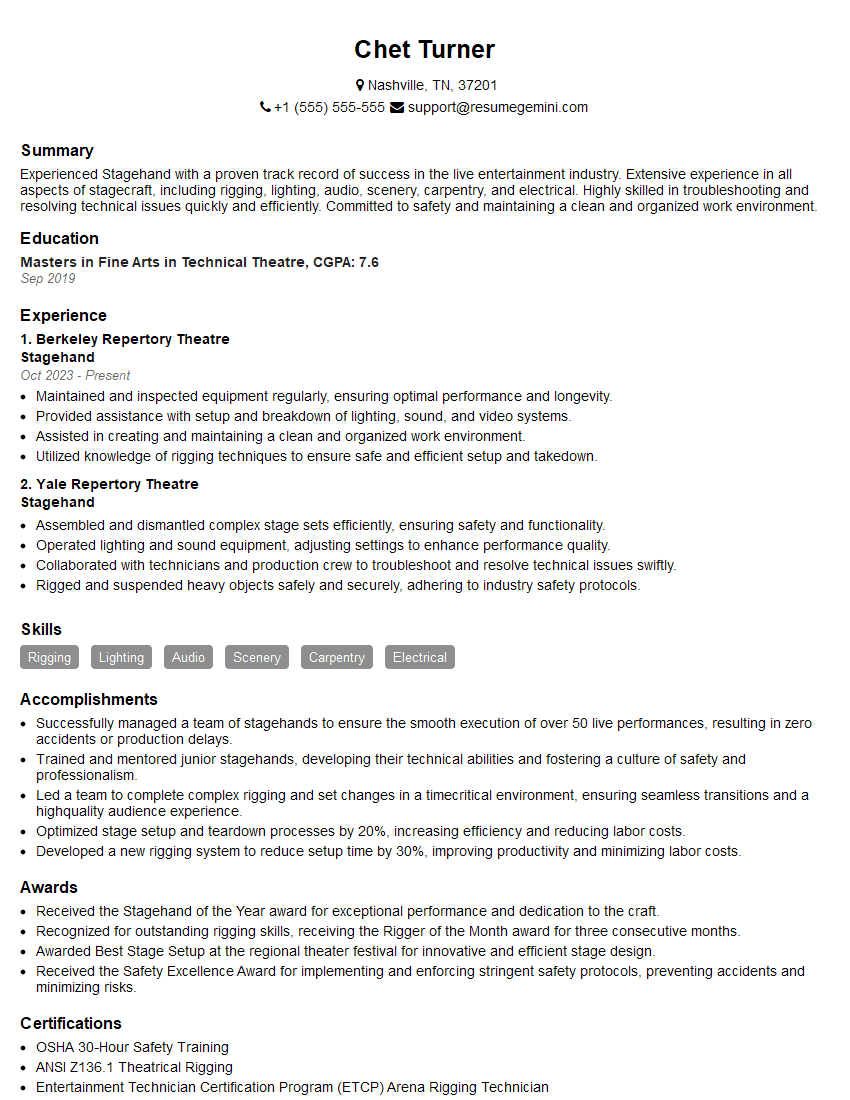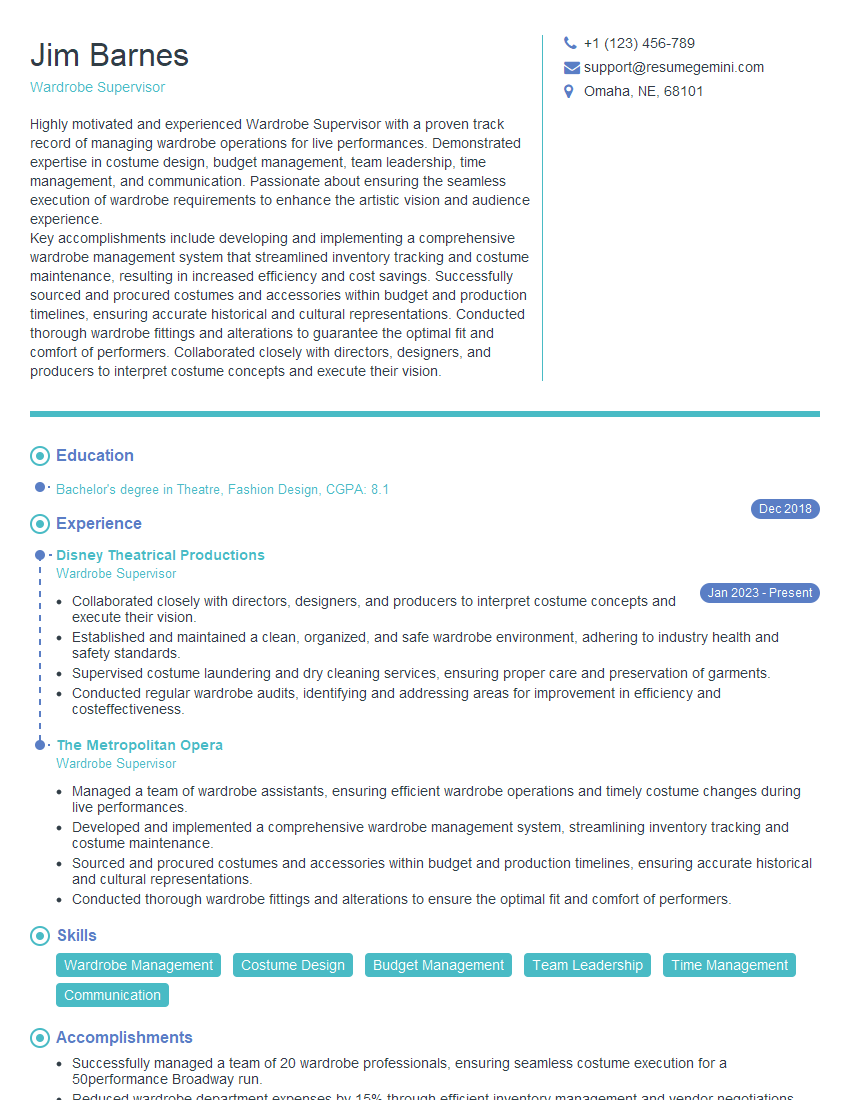The right preparation can turn an interview into an opportunity to showcase your expertise. This guide to Collaboration with Choreographers and Theatre Staff interview questions is your ultimate resource, providing key insights and tips to help you ace your responses and stand out as a top candidate.
Questions Asked in Collaboration with Choreographers and Theatre Staff Interview
Q 1. Describe your experience collaborating with choreographers on set design integration.
Collaborating with choreographers on set design integration requires a deep understanding of both dance and visual arts. It’s not just about placing dancers on a stage; it’s about creating a symbiotic relationship between movement and environment. My process begins with early conversations, often even before a full script is finalized. I’ll meet with the choreographer to discuss their vision: the mood, the story being told through movement, and the key moments they want to highlight. This informs my design process. For example, if the choreography involves a lot of swirling movement, I might design a set with curved lines and flowing fabrics to complement the fluidity. Conversely, sharp, angular movements might pair well with a more geometric set design.
I utilize sketches, mood boards, and even 3D models to visualize how the set will interact with the dance. I’ll present these to the choreographer and director for feedback, often incorporating their suggestions for adjustments and iterations. In one recent production, the choreographer wanted a set piece that could be both a backdrop and a prop that the dancers could interact with. We worked collaboratively to design a large, rotating screen that provided different visual textures depending on its position, seamlessly transitioning between background and active element. This required detailed discussion regarding the screen’s weight, movement capabilities, and safety for the performers.
Q 2. How do you manage conflicting artistic visions between the choreographer and director?
Conflicting artistic visions between a choreographer and director are common, but manageable with careful communication and a willingness to compromise. The key is to establish a collaborative environment where everyone feels heard and respected. I facilitate this by organizing regular meetings that include the choreographer, director, and key members of the design and production teams. In these meetings, we openly discuss our individual visions, identifying points of agreement and disagreement. We then use these discussions to find common ground, exploring alternative solutions that incorporate elements of each vision.
Sometimes, compromises are necessary. For instance, in one production, the director favored a minimalist set design while the choreographer envisioned a more elaborate one. We resolved this by creating a minimalist stage that cleverly incorporated modular elements. These smaller pieces allowed for dynamic configurations during the performance, satisfying both the director’s desire for visual simplicity and the choreographer’s need for set elements that interacted with the choreography.
My role is to act as a mediator, ensuring that everyone’s concerns are addressed and that we reach a unified vision that supports the overall artistic integrity of the production.
Q 3. Explain your process for scheduling rehearsals involving multiple artistic teams.
Scheduling rehearsals for multiple artistic teams requires meticulous planning and a clear understanding of each team’s needs. I start by creating a comprehensive master schedule that accommodates the rehearsal needs of the dancers, actors, musicians, and technical crews. This involves detailed timelines for individual rehearsals and joint rehearsals that involve multiple teams. I utilize project management software to track progress and manage conflicts.
For instance, I’ll block out specific time slots for the choreographer to work with the dancers, then schedule lighting and sound checks once the choreography is finalized. Technical rehearsals are then incorporated, allowing all the elements to come together. The software helps me manage resources effectively, ensuring we have access to essential spaces and equipment at the right time. Flexibility is key, so I build buffer time into the schedule to accommodate unexpected delays or the need for additional rehearsal time.
Clear communication is paramount throughout this process. Regular updates are sent to all involved teams, keeping everyone informed of the schedule and any changes. Open communication lines prevent misunderstandings and ensure that everyone is working collaboratively towards a shared goal.
Q 4. What strategies do you employ to ensure clear communication within a large creative team?
Clear communication within a large creative team is essential for a successful production. I employ several strategies to ensure this. Firstly, we establish a central communication hub, often a shared online platform, where all important documents, schedules, and updates are readily available. This ensures that everyone has access to the same information at the same time.
Regular meetings, both large group sessions and smaller team meetings, help maintain open communication and address concerns promptly. We use a combination of methods – emails for general updates, instant messaging for quick queries, and formal meetings for in-depth discussions and decision-making. Minutes are kept for all formal meetings, ensuring a record of decisions and actions is maintained. For large productions, I often appoint communication leads within each team, to streamline communication flow and ensure information dissemination is consistent.
Finally, fostering a culture of trust and respect is crucial. Everyone is encouraged to voice their opinions and concerns, ensuring that all voices are heard, fostering collaboration and reducing the potential for misunderstandings.
Q 5. How do you handle budget constraints when collaborating with choreographers on complex productions?
Budget constraints are a reality in most productions, and collaboration with choreographers on complex productions requires creative solutions to manage those constraints. The process begins with a thorough budget breakdown, identifying the costs associated with different aspects of the choreography, including rehearsal space, costumes, props, and technical elements. We prioritize essential elements, ensuring that the core artistic vision isn’t compromised while still finding ways to reduce costs where possible.
This might involve negotiating with vendors for discounted rates, exploring cost-effective alternatives for props or costumes, or opting for simpler set designs that are still visually impactful. Creative solutions are key – for instance, rather than buying expensive custom-made costumes, we might utilize existing wardrobe items and adapt them, saving significantly on production costs.
Early and transparent communication is crucial here. Keeping the choreographer involved in the budgeting process ensures that cost-cutting measures are implemented thoughtfully, preserving the integrity of the artistic vision while remaining fiscally responsible.
Q 6. Describe your experience troubleshooting technical issues during dance performances.
Troubleshooting technical issues during dance performances is a crucial part of my role. My experience has shown that thorough preparation is the best preventative measure. This involves meticulous pre-production planning, conducting thorough technical rehearsals and employing robust back-up systems. We anticipate potential problems and develop contingency plans to mitigate the impact of any unforeseen issues.
During performances, having a dedicated team of technicians who are adept at quickly diagnosing and resolving problems is vital. This requires clear communication channels and a well-defined chain of command. If a problem arises, we have systems in place to communicate the issue quickly and effectively to the relevant technicians while minimizing disruption to the performance. For example, if a lighting fixture malfunctions, we have back-up lights in place and a technician ready to switch to them as quickly as possible. In one instance, a section of the set unexpectedly collapsed. Our quick response team moved swiftly and safely to clear the debris, allowing the performance to resume with only a minor delay thanks to a carefully planned recovery strategy.
Q 7. How do you maintain a positive and collaborative environment during high-pressure situations?
Maintaining a positive and collaborative environment during high-pressure situations relies on strong leadership, open communication, and a shared commitment to success. Building trust and respect within the team is crucial. I ensure everyone understands their role and responsibilities, fostering a sense of ownership and team spirit. We celebrate small victories throughout the process to boost morale and maintain energy levels.
During stressful moments, I emphasize clear, concise communication, ensuring everyone stays informed and engaged. We utilize humour and de-stress strategies wherever appropriate to prevent the build-up of anxiety. For instance, short breaks are planned into rehearsal schedules to allow team members to recharge and reconnect. A collaborative problem-solving approach is employed, ensuring that all team members contribute solutions, helping them feel valued and engaged. This helps to diffuse tensions and maintain morale, leading to a stronger sense of unity and commitment to a successful outcome.
Q 8. What software or tools do you use to facilitate communication and collaboration with the creative team?
Effective communication and collaboration are paramount in theatrical productions. My approach relies on a multi-faceted toolset, adapting to the specific needs of each project. For instance, we often use project management software like Asana or Trello to track tasks, deadlines, and revisions for choreography, set design, costumes, and other elements. These platforms allow for seamless sharing of documents, updates, and feedback. For real-time communication, we leverage tools like Slack or Microsoft Teams for quick queries, discussions, and brainstorming sessions. These channels are particularly beneficial during rehearsals for instant problem-solving. Finally, Google Drive or similar cloud storage services allow everyone to access and update shared files conveniently, ensuring everyone is working with the latest versions.
For example, during a recent production of a modern dance piece, we used Asana to manage the creation of the choreography. The choreographer could assign tasks to individual dancers, upload video files of rehearsals, and leave comments for specific improvements. The production team simultaneously used Trello to manage the prop creation and set design related to those choreographic sections. This allowed us to track the progress of multiple aspects of the production simultaneously and efficiently.
Q 9. Explain your experience with incorporating safety protocols in choreography and stage management.
Safety is an absolute priority throughout the entire production process. My approach starts with comprehensive risk assessments conducted at the beginning of pre-production. We identify potential hazards – from stage falls and equipment malfunctions to overuse injuries in demanding choreography. We then develop and implement detailed safety protocols and training programs for all personnel involved, including dancers, stagehands, and technical crew. These protocols cover areas such as safe lifting techniques, proper use of equipment, emergency procedures, and first aid. Regular safety briefings are held throughout rehearsals and performances to reinforce key safety procedures.
For example, before rehearsals for a production involving complex aerial work, we organized a comprehensive safety training session led by a certified rigger. Dancers received detailed instruction in using safety harnesses, performing checks, and understanding emergency protocols. We also included comprehensive stretches and warm-ups designed to mitigate injury risk.
Q 10. How do you adapt to changing creative requirements during the production process?
Adaptability is crucial in the fast-paced environment of theatre. My strategy for handling changing creative requirements involves open communication and flexible planning. We use agile project management techniques, embracing iterative development and allowing for adjustments along the way. Regular meetings, involving all stakeholders, facilitate transparent communication about changes, allowing us to collectively brainstorm solutions and incorporate the adjustments into the overall production schedule and budget. This may involve re-allocating resources, modifying the rehearsal schedule, and adjusting choreographic elements or set design as needed.
For instance, we once had a significant set piece delayed due to manufacturing problems. We immediately convened a meeting including the choreographer, set designer, and production manager to assess the impact. The choreographer quickly adapted parts of the choreography to accommodate the change in the stage setting; utilizing different sections of the set to minimize disruption to the narrative of the piece.
Q 11. How would you address disagreements about artistic choices between the choreographer and performers?
Disagreements are inevitable in any collaborative artistic endeavor. My approach emphasizes respectful communication and mediation. I facilitate a neutral environment where the choreographer and performers can openly express their concerns and perspectives without fear of judgment. I encourage active listening, clarifying each party’s motivations and goals. The focus is on finding common ground and exploring creative compromises that honor everyone’s artistic vision while maintaining the overall integrity of the production. Sometimes, this requires seeking outside perspectives from a neutral artistic director or consultant.
In one instance, a performer disagreed with the choreographer’s interpretation of a particular movement sequence. I facilitated a discussion that helped the choreographer understand the performer’s physical limitations and artistic concerns. Together, they developed a modified sequence that met both their artistic vision and physical constraints. This collaborative approach strengthened the relationship between the choreographer and the performer and resulted in a stronger performance.
Q 12. Describe your experience in managing the rehearsal schedule and communication with choreographers and performers.
Managing the rehearsal schedule and communication requires meticulous planning and proactive communication. I begin by creating a detailed rehearsal schedule that considers the complexity of the choreography, the dancers’ availability, and the overall production timeline. I distribute this schedule to all stakeholders well in advance, using a shared calendar system (like Google Calendar) to allow for efficient scheduling. Regular progress meetings keep everyone informed of the schedule and identify any potential conflicts or challenges early on. Open communication channels, like daily check-ins via Slack, are utilized to ensure quick responses to any queries or changes in the schedule.
During a demanding musical theatre production, I used a colour-coded Google calendar to manage rehearsals. Different colours represented different rehearsal groups (e.g., dancers, singers, actors), making it easy to visualize potential schedule clashes. I also used the calendar to schedule individual sessions with the choreographer and lead performers to ensure any challenges are tackled promptly. This streamlined communication and minimized disruption to the production timeline.
Q 13. What is your process for ensuring the timely execution of choreographic elements within the overall production schedule?
Ensuring timely execution of choreographic elements involves meticulous integration of choreography into the overall production timeline. This starts with clear communication between the choreographer and the production team right from the outset, creating a detailed choreography schedule that aligns with the broader production schedule. Regular progress meetings are held to track the progress of choreography, identifying any potential delays or challenges early on. This enables timely adjustments to the rehearsal schedule or the choreography itself. Milestones and deadlines are explicitly set for key choreographic elements to allow for the integration of lighting, sound, and set design. Regular walkthroughs help visualise the choreography in relation to other elements, allowing for early detection and resolution of any potential issues.
In a recent production, we created a detailed Gantt chart illustrating the choreography’s integration with lighting and sound design. This visual aid highlighted critical dependencies and potential scheduling conflicts. The chart allowed us to identify and address potential issues early in the process, ensuring seamless integration of all aspects of the production and efficient use of rehearsal time.
Q 14. How familiar are you with various dance styles and their technical requirements?
My familiarity with various dance styles is extensive. I have a deep understanding of various dance techniques, ranging from classical ballet and contemporary dance to hip-hop and jazz. This understanding is not only theoretical; I have practical experience working with choreographers and dancers from various backgrounds. I understand the technical requirements of each style, including the physical demands on performers, the specific equipment needed, and the stylistic nuances that need to be considered. This broad knowledge base allows me to collaborate effectively with choreographers across different disciplines, providing effective support and ensuring the highest quality of performance.
For instance, in one production that included elements of both ballet and contemporary dance, I was able to effectively manage the rehearsal schedule and ensure that the needs of each style were met. I coordinated the usage of the appropriate floors, ensured the necessary equipment was available, and effectively communicated with choreographers to minimize rehearsal overlap and maintain a safe and productive workflow.
Q 15. Describe your approach to problem-solving in a fast-paced production environment involving choreography.
In a fast-paced production environment, effective problem-solving hinges on proactive communication, adaptability, and a structured approach. My strategy begins with clearly defining the problem, gathering input from all relevant parties (choreographer, director, technical staff), and brainstorming solutions collaboratively.
I utilize a prioritization matrix to weigh the urgency and impact of each issue, focusing on the most critical challenges first. This might involve identifying bottlenecks in the rehearsal process, resolving technical difficulties with costumes or set pieces that impact choreography, or addressing scheduling conflicts. For example, if a crucial prop is unavailable, I’d immediately explore alternatives, such as substituting with a similar prop, adapting the choreography, or delaying the affected scene if possible. The key is to remain flexible and explore multiple solutions concurrently. Finally, post-problem resolution, a brief debrief is crucial to learn from the experience and prevent similar issues in the future.
Career Expert Tips:
- Ace those interviews! Prepare effectively by reviewing the Top 50 Most Common Interview Questions on ResumeGemini.
- Navigate your job search with confidence! Explore a wide range of Career Tips on ResumeGemini. Learn about common challenges and recommendations to overcome them.
- Craft the perfect resume! Master the Art of Resume Writing with ResumeGemini’s guide. Showcase your unique qualifications and achievements effectively.
- Don’t miss out on holiday savings! Build your dream resume with ResumeGemini’s ATS optimized templates.
Q 16. How do you manage the expectations of a choreographer who has a specific vision for their work?
Managing a choreographer’s expectations requires open communication, empathy, and realistic planning from the outset. I begin by having in-depth discussions with the choreographer, understanding their artistic vision in detail. This includes clarifying their requirements for space, equipment, and performers’ skills, translating their vision into tangible production plans.
Regular progress meetings and detailed documentation of agreed-upon plans are vital to keep expectations aligned. When challenges arise – be it budget constraints, technical limitations, or performer availability – I proactively address them transparently, presenting alternative solutions while emphasizing the reasons for any deviations from the initial plan. I view compromise not as a failure but as a collaborative process leading to a successful and potentially even enhanced production. I might say something like, “While we can’t achieve the initial vision for the aerial sequence due to safety concerns, we can explore this equally striking ground-based alternative.” This demonstrates both respect and a proactive approach to problem-solving.
Q 17. What is your understanding of intellectual property rights concerning choreography?
Understanding intellectual property rights (IPR) related to choreography is crucial. Choreography, like other artistic works, is protected by copyright. This means that the choreographer owns the exclusive rights to reproduce, distribute, display, and adapt their work. This protection extends to the choreography’s notation, video recordings, and even the live performance itself.
Before production begins, I ensure that clear contracts are in place, outlining the choreographer’s rights, usage rights granted to the production, and any associated fees or royalties. It’s essential to document explicitly who owns the copyright and under what conditions the choreography can be used for performances, recordings, or other purposes. Ignoring these aspects can lead to costly legal battles and reputational damage.
Q 18. Describe a time you had to negotiate compromises between artistic vision and practical limitations.
In one production, the choreographer envisioned a breathtaking final scene involving a large-scale aerial sequence with complex lifts and intricate formations. However, due to budget restrictions, we couldn’t afford the specialized rigging equipment necessary to ensure the safety of the performers.
Negotiating this compromise involved a series of collaborative brainstorming sessions with the choreographer. We explored various alternatives, eventually settling on a revised choreography that maintained the emotional impact and visual spectacle but utilized ground-based movement. We incorporated innovative lighting and projections to create a visually captivating effect, replacing the aerial elements with equally dynamic ground-based formations. Though the final product differed from the initial vision, the result was a successful and artistically satisfying performance, showcasing the value of compromise and creative problem-solving.
Q 19. How do you ensure that the choreography is integrated smoothly with the other elements of the production (set, lighting, sound)?
Integrating choreography seamlessly with other production elements requires early and consistent collaboration. This begins with regular meetings involving the choreographer, set designer, lighting designer, and sound designer, from the initial design stages. We utilize shared digital platforms for visual representations of the choreography and the stage design to prevent miscommunications.
For instance, lighting cues are carefully timed to accentuate specific movements in the choreography, while sound design reinforces the mood and rhythm of each sequence. The set design must provide enough space and appropriate surfaces to execute the choreography safely. Regular rehearsals with all departments allow us to refine the synchronization of these elements, creating a unified and cohesive performance. This collaborative approach ensures that all artistic elements are working together to tell the story in a unified and powerful way.
Q 20. Describe your process for reviewing and providing feedback on choreography.
My choreography review process is structured and constructive. It begins with observing several rehearsals, taking detailed notes on technical aspects, artistic choices, and flow. I focus on both the overall effectiveness of the choreography and the details of execution.
After observation, I provide feedback in a structured meeting, starting with positive observations and then offering constructive criticism, focusing on specific sections and suggesting improvements or alternatives. I prioritize clear and respectful communication, ensuring that the choreographer feels understood and supported. I always make it clear that the goal is to make the choreography even better, not to impose my artistic vision. This process necessitates tact and diplomacy, remembering that the choreographer is the artistic authority on their own work.
Q 21. What techniques do you utilize to maintain a collaborative relationship with a demanding choreographer?
Maintaining a positive collaboration with a demanding choreographer requires patience, empathy, and strong communication skills. I believe in establishing a trusting relationship built on mutual respect and clear expectations from the outset.
I actively listen to their concerns and feedback, making sure to validate their artistic vision before offering alternative solutions. I emphasize the importance of collaboration, framing challenges not as obstacles but as opportunities for creative problem-solving. By proactively addressing potential issues, demonstrating flexibility, and maintaining open and honest communication, I can manage even the most demanding situations constructively, fostering a respectful working relationship and ultimately, achieving a successful production.
Q 22. How do you ensure the safety of the performers during rehearsals and performances, especially considering choreography?
Ensuring performer safety is paramount. It’s a multifaceted approach that begins long before rehearsals even start. We conduct thorough risk assessments of the choreography, identifying potential hazards like high falls, intricate lifts, or rapid changes in direction. This assessment informs the creation of a comprehensive safety plan.
- Warm-up and cool-down routines: Mandatory and tailored to the specific physical demands of the choreography. We work with a physiotherapist to design these routines to prevent injury.
- Spotters and safety personnel: For complex lifts or potentially dangerous movements, trained spotters are always present. In some productions, we even have a dedicated safety officer overseeing all rehearsals and performances.
- Rehearsal space safety checks: The rehearsal space itself is meticulously checked for hazards – loose cables, uneven flooring, obstructions etc. We ensure adequate lighting and ventilation.
- Communication and clear instructions: Choreographic instructions must be crystal clear, leaving no room for misinterpretation. We employ visual aids, detailed diagrams, and repeated practice sessions to ensure everyone understands their responsibilities.
- Emergency protocols: A well-defined emergency action plan is essential, including procedures for dealing with injuries, medical emergencies, and evacuations. The entire team is thoroughly briefed on these protocols.
For example, in a recent production involving aerial silks, we incorporated a comprehensive safety briefing, mandatory pre-rehearsal checks of the equipment, and had two experienced riggers present throughout every rehearsal and performance. This meticulous approach resulted in zero injuries throughout the production run.
Q 23. Describe your experience with various rehearsal spaces and their impact on choreography.
My experience spans a variety of rehearsal spaces, from large, well-equipped studios to repurposed warehouses and even outdoor locations. The space significantly impacts the choreography. A spacious, high-ceilinged studio allows for expansive movements and complex formations, while a smaller, more confined space necessitates a more contained and intricate choreography.
- Studio spaces: Offer ideal conditions – sprung floors (to cushion impact), mirrors for self-correction, good lighting, and ample room for movement.
- Warehouse spaces: Often present challenges like uneven flooring, limited lighting, and potential safety hazards, demanding choreography be adapted for those constraints.
- Outdoor locations: These introduce unpredictable elements like weather, uneven terrain, and limited control over sound and lighting, requiring flexible choreography that accounts for these variables.
For instance, adapting a dynamic, expansive dance sequence designed for a large studio to a smaller theatre required breaking the choreography into smaller, more manageable sections, reducing the scope of the overall movement and focusing on details within a smaller space. Conversely, when working outdoors, I’ve incorporated elements like wind and light into the choreography, transforming them from constraints into expressive features.
Q 24. What strategies do you use to manage the physical and emotional demands on performers during intensive rehearsal periods involving complex choreography?
Managing the physical and emotional demands during intensive rehearsal periods is crucial. It requires a holistic approach that combines physical training, mental wellness strategies, and effective communication.
- Progressive rehearsal scheduling: We build up intensity gradually, avoiding overwhelming the performers. Regular breaks are incorporated, and rehearsal days are structured to allow for rest and recovery.
- Cross-training and injury prevention: Incorporating Pilates, Yoga, or other strengthening exercises aids in preventing injuries and building stamina. Regular consultations with physiotherapists are also critical.
- Open communication and feedback sessions: Creating a safe space for performers to express their physical and emotional needs is essential. This allows early identification and address of fatigue, stress or frustration.
- Mindfulness and stress management techniques: We encourage the use of mindfulness exercises, meditation, or other stress-reduction techniques to help performers manage the pressure.
- Nutritional guidance and hydration: Providing guidance on proper nutrition and hydration ensures the performers are optimally fueled for the demanding rehearsal schedule.
In one particularly demanding production, we implemented daily 15-minute mindfulness sessions, introduced additional rest breaks, and offered optional yoga sessions, leading to increased resilience and a reduction in injuries amongst the cast.
Q 25. How familiar are you with different performance styles and how they impact choreographic decisions?
Familiarity with different performance styles is fundamental. My experience encompasses ballet, contemporary, jazz, hip-hop, and more. Each style necessitates a different approach to choreography. For example, the precision and technique required for ballet contrast sharply with the freedom and improvisation often found in contemporary dance.
- Ballet: Requires intricate footwork, precise lines, and classical positions. Choreography will prioritize these elements.
- Contemporary: Emphasizes fluidity, expressiveness, and often incorporates floor work. Choreography would be more improvisational and emotionally driven.
- Hip-Hop: Focuses on rhythmic movement, sharp isolations, and often incorporates street dance elements.
Understanding these styles allows me to create choreography that is both aesthetically pleasing and technically feasible for the performers. For a recent production that blended ballet and contemporary, I adapted the choreography to seamlessly transition between the two styles, highlighting the strengths of each while maintaining the stylistic integrity of both.
Q 26. How do you facilitate communication between the choreographer and the technical crew (lighting, sound, set)?
Effective communication between the choreographer, the technical crew, and performers is crucial. This is achieved through regular meetings, detailed documentation, and clear communication protocols.
- Regular meetings: Frequent meetings between the choreographer, lighting designer, sound designer, set designer, and stage manager ensure that everyone is on the same page regarding the design and execution of the production.
- Detailed documentation: We create detailed cue sheets, lighting plots, sound plots, and set designs. These documents serve as a blueprint, ensuring that everyone understands their individual roles and responsibilities.
- Technical rehearsals: Dedicated technical rehearsals are essential to test and refine the integration of lighting, sound, and set with the choreography. It allows for problem-solving and fine-tuning.
- Open communication channels: Maintaining open communication channels, such as shared online documents or collaborative software, ensures that everyone is aware of any changes or updates throughout the process.
For example, we use a shared online document to track lighting cues, sound cues, and choreography timing, allowing all members of the team to offer input and feedback. This transparency minimizes errors and improves efficiency.
Q 27. Describe a time you had to adjust choreography due to unforeseen circumstances or technical limitations.
In one production, a critical piece of set malfunctioned during the tech rehearsals. It was a large rotating platform central to a key scene in the choreography. This required immediate adaptation.
We collaborated with the set designer and the technical crew to assess the problem. Since a complete repair was impossible within the timeframe, we adjusted the choreography to remove any movements that specifically utilized the malfunctioning rotation feature. We substituted it with a different visual effect using strategically placed lighting and dancers’ movements. This required creative problem-solving and close collaboration to deliver a satisfying production despite the unforeseen circumstances.
Key Topics to Learn for Collaboration with Choreographers and Theatre Staff Interview
- Understanding Choreographic Process: Explore the stages of choreography development, from initial concept to final performance. Learn to identify the choreographer’s artistic vision and how to contribute effectively.
- Effective Communication & Feedback: Practice providing constructive criticism and receiving feedback gracefully. Learn active listening techniques and strategies for clear and concise communication in a collaborative environment.
- Technical Aspects of Theatre Production: Gain familiarity with stage management, lighting, sound, costume, and set design principles. Understand how your role interacts with these departments.
- Problem-Solving & Adaptability: Discuss how to navigate challenges that arise during rehearsals and performances. Showcase your ability to find creative solutions under pressure and adapt to changing circumstances.
- Respecting Artistic Vision: Demonstrate an understanding of the importance of respecting the choreographer’s artistic vision while contributing your expertise and skills effectively. Discuss how to balance collaboration with maintaining artistic integrity.
- Conflict Resolution: Explore strategies for resolving conflicts that may arise among team members. Highlight your ability to mediate disagreements and maintain a positive working environment.
- Teamwork & Collaboration Dynamics: Discuss your understanding of effective teamwork in a fast-paced environment. Showcase examples of successful collaborations and your contribution to team success.
Next Steps
Mastering collaboration with choreographers and theatre staff is crucial for career advancement in the performing arts. A strong understanding of these collaborative processes significantly enhances your value to any production team. To increase your job prospects, focus on building an ATS-friendly resume that highlights your relevant skills and experiences. ResumeGemini is a trusted resource that can help you create a professional and impactful resume. We provide examples of resumes tailored to showcasing experience in collaborating with choreographers and theatre staff to help you get started.
Explore more articles
Users Rating of Our Blogs
Share Your Experience
We value your feedback! Please rate our content and share your thoughts (optional).
What Readers Say About Our Blog
Hello,
We found issues with your domain’s email setup that may be sending your messages to spam or blocking them completely. InboxShield Mini shows you how to fix it in minutes — no tech skills required.
Scan your domain now for details: https://inboxshield-mini.com/
— Adam @ InboxShield Mini
Reply STOP to unsubscribe
Hi, are you owner of interviewgemini.com? What if I told you I could help you find extra time in your schedule, reconnect with leads you didn’t even realize you missed, and bring in more “I want to work with you” conversations, without increasing your ad spend or hiring a full-time employee?
All with a flexible, budget-friendly service that could easily pay for itself. Sounds good?
Would it be nice to jump on a quick 10-minute call so I can show you exactly how we make this work?
Best,
Hapei
Marketing Director
Hey, I know you’re the owner of interviewgemini.com. I’ll be quick.
Fundraising for your business is tough and time-consuming. We make it easier by guaranteeing two private investor meetings each month, for six months. No demos, no pitch events – just direct introductions to active investors matched to your startup.
If youR17;re raising, this could help you build real momentum. Want me to send more info?
Hi, I represent an SEO company that specialises in getting you AI citations and higher rankings on Google. I’d like to offer you a 100% free SEO audit for your website. Would you be interested?
Hi, I represent an SEO company that specialises in getting you AI citations and higher rankings on Google. I’d like to offer you a 100% free SEO audit for your website. Would you be interested?
good

